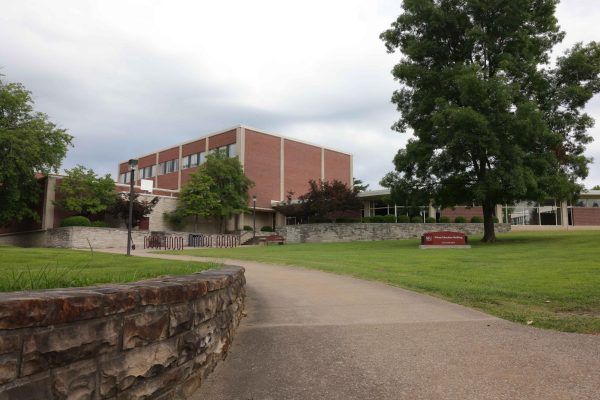Black community wants soil retested for contamination and SIUC soil expert agrees
Environmental contamination issues stemming from the Kopper’s Superfund site in Carbondale, Illinois, have been a decades-long flashpoint between mostly-Black residents on the city’s northeast side, private businesses and various government agencies.
Residents trace their struggle to have the site tested, monitored and cleaned to the area’s history of segregation.
Rodney Morris, a northeast side Carbondale resident who has been fighting this issue for the last ten years, said the communication between the Black community, the federal Environmental Protection Agency (USEPA), and the city has mostly amounted to various groups attempting to shift blame and responsibility.
Advertisement
Nearby residents demanded in June 2021 that their residential property be retested because previous tests used inaccurate soil sampling techniques. Those challenged tests showed no contamination and no risk of exposure to toxic chemicals.
Morris said the USEPA never tested south of the fence around the Kopper’s property, although there is a map showing a few areas along the fence line the agency reportedly tested, concluding it would not need to test beyond that point.
“Still, the creeks that got filled with creosote would come through the neighborhood, and the contaminated air would come into the neighborhood, dust would blow into the neighborhood,” Morris said. “There’s no way that it couldn’t be contaminated further than south of the fence… They just refuse to pay to test it.”
The land located at 1555 North Marion Street in Carbondale, Illinois, was initially owned by the Ayer and Lord Tie company and considered the largest creosote plant globally.
The railroad tie production facility was operational from 1902 and was officially closed after finding onsite contamination in 1991.
Beazer East Incorporated bought the land in the late 1980s and conducted Resource Conservation and Recovery Act Corrective Action activities under the USEPA Region 5 office in Chicago.
Site investigations identified the primary contaminants as creosote, pentachlorophenol, polycyclic aromatic hydrocarbons, dioxin/furan compounds, and arsenic, which can all harm humans.
Advertisement*
The Food and Drug Administration (FDA) says long-term exposure to high levels of arsenic is associated with higher rates of skin cancer, bladder cancer, and lung cancer, as well as heart disease.
Dioxin/furan is likely to be a cancer-causing substance to humans, according to the USEPA. People unintentionally exposed to large amounts of these chemicals have developed a skin condition called chloracne, as well as liver problems.
Marilyn Tipton, a resident of the northeast side whose father worked at the Kopper’s facility, said with all of the contamination in the ground, she would not grow a garden because it would contaminate her vegetables.
“I had tried to grow a garden, but was just scared to eat it,” she said.
Tipton is a member of Carbondale Spring Food Autonomy, known for organic gardening, and the group would like to put a garden in the northeast neighborhood.
“Until we can find funding to get this land tested, there is no way that we could put an organic garden over here because we wouldn’t know if the food would poison us or not,” she said.
Tipton said Beazer selected her property to get tested for contamination, and she completed all the paperwork, scheduled a date, and told Beazer East she would like to be present while it conducted the soil sampling.
Beazer representatives called Tipton the day before they were scheduled to arrive, and said they’d found a different property to test.
“It made me feel bad… It made me feel helpless because… they didn’t want to test my property,” Tipton said. “Did they find somewhere else because I asked to be here while they did the testing?”
Morris said the EPA knows that they are Black and poor, and the northeast side does not have the money to retest the ground themselves. If they were able to retest the ground, he is positive that their land would be contaminated.
“They only did a surface check of the land, and they didn’t do what is considered a real test,” Morris said. “Now, my point has always been if they come in and test the soil, and the soil is not contaminated… all the money they spend arguing, fussing, and fighting with us… if the land weren’t contaminated, we wouldn’t have anything to say.”
Morris said the EPA Region 5 office that oversaw this issue is the same region that told Flint, Michigan, its water was safe.
“We are just a bunch of Black people that are being deceived,” he said.
Morris said the city tried to pacify Black residents when the Planning and Zoning Commission said no to land developer Brightfield’s special use permit proposal to install a solar array farm on Kopper’s site in 2018.
“They gave us a blanket to lay down in hopes that it would rock us to sleep,” Morris said.
Morris said the city could have had the solar operation on the Koppers site if they had proved that the land was safe, but they did not.
“They don’t want to come over here and test because the results are going to be that our land is contaminated… it is just that simple,” Morris said. “It’s a joke… It’s really a joke.”
Morris said he isn’t trying to get the EPA and Beazer to test his land, specifically.
“It could’ve been across the street from me, it could’ve been the land next door to me, it could’ve been the land behind me,” Morris said. “Just land south of the fence.”
Brian Klubek, a former microbiology professor at SIU in the Department of Plant, Soil and Agriculture Systems, said the residents are right. The soil samples did not go deep enough to detect contamination.
Klubek said the residents asked him to get involved in demanding the retesting of the soil located south of the Koppers site for hazardous chemicals, specifically in their backyards.
Klubek said residents can’t be sure no contamination in those yards exists if the city or EPA do not look.
“It struck me that they only took samples at the surface six inches, and that was it. After that, they never went any deeper,” Klubek said.
Klubek said if the sampling does not go any deeper, the sampling team really can not say the land is contamination-free.
“I believe they took a 6-inch sample from the soil surface and no deeper,” Klubek said. “I would not expect to detect high concentrations of dioxins or furans when these compounds have the potential to move deeper into the soil or be removed by run-off.”
Soils at that location, called urban soils or human-modified soils, no longer possess the profile characteristics they had beforehand.
“Nevertheless, there are soil samples located near that same area that are pretty much similar to poorly drained soil samples. So, that site was probably the same,” Klubek said.
In ecology, poorly drained soil is a condition in which water is removed from the soil so slowly that the soil is saturated periodically during the growing season or remains wet for long periods.
Klubek said the soil profile must be considered in situations like this.
“When these soils are wet, we call them tight because they do not drain very easily… you have pooling of water at the surface. However, when you get past the rainy season, it gets very, very hot, and it dries out,” Klubek said. “It starts forming cracks within the profile itself.”
Water moves and starts infiltrating more easily into the soil when it starts raining again because of those cracks, Klubek said. A team can take samples of dioxin/furans or organic compounds there.
Klubek said a band of these compounds are usually no thicker than two or three inches, and, if that band exists, where it is and how close it is to the soil surface would dictate if it were a risk or not to human health and the environment.
“So if the band is at the 10-inch, there’s a potential risk there because you’re treating soil modification at the soil surface as your chance to modify the soil, bring that soil back up, and bring that stuff back up,” Klubek said. “On the other hand, if it’s down at the 23-inch depth, that would make a safer difference because you won’t go down that deep, and that will just sit there, and then there’s no potential risk.”
Klubek said the city needed a grid-type sampling system, especially for the residents right next to the Koppers field.
“They didn’t cut by a grid system… they [were] just helter skelter, here and there, and maybe took one or two samples out of the yards that live next to it,” Klubek said. “They went several blocks beyond that, just healter, skelter.”
The city cannot adequately analyze the results because the testing was too scattered, Klubek said.
Tipton said the soil still needs to be tested in her backyard.
“We will not be satisfied until the soil is tested right,” Tipton said.
Donald Monty, a retired Carbondale city manager and who observed the soil sampling to ensure a proper supplemental investigation, said mistrust of the local government and governmental agencies is a part of a long history of segregation and racism in the United States southern regions.
“The lunch counters would not allow Blacks, the movie theaters would not allow Blacks…they had to sit up in the balcony, or Blacks could not stay at hotels and so on,” Monty said.
He said Southern Illinois is south of Louisville, Kentucky, so in many respects, the old culture around Carbondale was probably more akin to what it would have been like in the south than, say, in a northeastern city.
“In the 1960s, the Varsity Theater then was the big movie theater in town and finally allowed black patrons to sit mingled with the white patrons,” Monty said. “So you have got that as a background not much different than if you were to go talk to people in rural Kentucky or Tennessee or Alabama… maybe not as blatant, but nonetheless.”
Monty said additional testing would be worth doing, but to keep in mind that the resident’s have a deep mistrust of the EPA and city.
Mike Slenska, environmental manager for Beazer East Inc., said Beazer has already conducted such soil testing as part of the site investigation process, both along the site’s southern property boundary and residential parcels located south of the site.
“The residential parcel soil sampling conducted by Beazer occurred in 2012, and the results of the sampling included in the site’s 2015 Human Health Risk Assessment,” Slenska said.
According to the Field Sampling Activity report included in the Human Health Risk Assessment, the sampling team was composed of Caroyln Bury of USEPA, Tom Edmundson of Illinois EPA, and Rob Young of TechLaw Incorporated in 2005.
TechLaw Inc. is an environmental consultant that helps government and commercial clients assess performance, manage risk, implement sustainable remedies, and resolve uncertainty, according to their site.
According to the report, the sampling team collected fourteen soil samples for PAH and PCP analysis based on a review of the existing onsite data and input from northeast community representatives, including one sample from the Koppers facility in an area known for contamination and one background sample from a residential area.
According to the report, the samples were analyzed for polycyclic aromatic hydrocarbons (PAHs) and pentachlorophenol (PCP) to determine whether contamination from the Koppers facility had migrated off-site into the neighboring community.
According to the Centers for Disease Control (CDC), pentachlorophenol causes neurological, blood, and liver effects through acute inhalation exposures to humans.
According to the Illinois Department of Public Health (IDPH), similar health effects can happen when exposed to polycyclic aromatic hydrocarbons coupled with repeated skin contact, resulting in redness and inflammation of the skin.
According to the report, samples were collected from depths of approximately zero to six inches below the ground surface.
The sampling team compared the results to EPA Region 9 Preliminary Remediation Goals (PRG) and the Illinois Tiered Approach to Corrective Action Objectives (TACO) guidelines for residential properties to determine if the concentrations of PAHs and PCP detected in the soils could be potentially harmful to residents.
“The sampling team met with representatives of the neighboring community the day before the sampling event [and] the sampling team used the community representatives input and existing onsite data in establishing the soil sample locations.”
Surface soil sample 13, for instance, was collected in the Koppers Former Process Area, from within the facility’s boundaries that appeared to be visibly impacted by creosote because the objective was to obtain a “signature” of the PAHs present in the creosote-impacted soils at the facility.
Another soil sample location featured a large area southeast of the Koppers site and south of the property line, which Kopper’s managers had reportedly used to store treated railroad ties several years ago.
According to the report, sampling locations included locations north, west, and east of the Koppers site. In addition, the surface soil samples collected from Oakdale Park and a recreation area located in north-central Carbondale were considered a background sample and located approximately one mile west of the facility.
The results of PCP analysis did not detect PCP at a high concentration in any sample other than one sample exceeding PRG and TACO guidelines, the Illinois Environmental Protection Agency’s (IEPA) method for developing remediation objectives for contaminated soil and groundwater. These remediation objectives protect human health and take into account site conditions and land use for residential exposures, according to the IEPA.
Additionally, the background sample did not detect PCP, nor was the chemical detected in any soil supplies collected outside the boundaries of the Koppers site.
“The exceedance was expected since the sampling team collected sample 13 from onsite soil material that contained visible creosote,” the report said. “Sample one was collected adjacent to a large drainage feature and an associated sample two collected in a step-out pattern to the south of the sample; one did not contain PAHs or PCP at concentrations exceeding the residential criteria.”
The report also said that the scientist rejected PCP results in six soil samples because of low surrogate recoveries and low calibration response. Target analytes may not have been detected if present in low concentrations.
The non-detected results, for instance, were rejected because the recoveries of the acid surrogates two-fluorophenyl and phenol-d5, which are PCP compounds, were less than 10 percent below laboratory quality control limits.
The following year, the city of Carbondale completed a supplemental investigation because northeast residents were still raising concerns about possible health hazards and water contamination in their neighborhood.
David Kimmle, a civil engineer for Hurst-Rosche Engineers Inc., said that topographic information, including the presence of waterways and other bodies of water, should be considered when establishing a sampling plan.
According to the Field Sampling Activity report, 11 subsurface soil samples were collected at six locations throughout the local neighborhood.
Kimmle said both random and grid-type sampling plans are appropriate based on the nature of the contamination, intent of the sampling program, and availability of historical information or previous sampling results.
“With random sampling, test locations are selected separately, randomly, and independently of previous sample locations,” Kimmle said. “With grid sampling, test locations are selected systematically at given intervals.”
Random sampling is appropriate if sample locations are selected randomly with uniform coverage, whereas grid sampling ensures the entire area of sampling is systematically covered.
“With both sampling plans an appropriate number of samples must be collected to establish the desired level of confidence in the sampling plan,” Kimmle said.
Kimmle also said selection of supplemental and specific test locations is appropriate after the results of a random or grid sampling program are available.
Jennifer Sandorf, a project geologist formerly with Blasland, Bouck, and Lee Incorporated, which later merged with Arcadis Incorporated who conducted onsite soil sampling for Beazer, was present during the sample collection with Kimmle.
Kimmle said the sampling team used a post-hole digger to dig down to the one feet depth at each designated location to test for PAHs and PCP as the EPA did the year before using the same method.
“Sandorf collected split samples on behalf of Beazer [and] Monty also accompanied the sampling team,” Kimmle reported. “An auger was then used to auger down to the two feet depth, where a second soil sample was obtained and split by Sandorf.”
Kimmle also said the appropriate depth to detect toxins is dependent on numerous conditions, including but not necessarily limited to soil type and profile, presence of groundwater, and means by which the potential contaminate may have entered the subsurface. Without this information an appropriate depth of sampling cannot be recommended.
Kimmle agreed with Klubek in regard to consideration of soil profile and its characteristics in the soil sampling process.
“Yes, the soil profile and soil characteristics… along with many other factors… must be considered when establishing a sampling plan and sampling depth,” Kimmle said. “The soil type and soil profile may dictate the ability for toxins to migrate within the subsurface.”
Monty said he does not remember why the two-foot depth was determined. However, the local soil tends to form a “hardpan” just a couple of feet below the surface. This hardpan is particularly impervious to water percolating through it.
According to soil research done by the University of California Agriculture and Natural Resources, hardpan forms when the tillage presses soil directly below it together, forming a compacted layer. Deep compaction occurs further down in the soil profile caused by excessive weight on soil, mainly when soil is wet. It can be hard to break up soil once deep compaction occurs.
“Maybe this was a factor in deciding how deep to take the samples,” Monty said.
Only 11 soil samples were taken as a matter of practice by the sampling team, Monty said. When sampling, the team does not test 100 percent of the lots. Instead, they select a “representative” sample of scattered sites throughout the area of concern.
“If testing at one or more of the sites turns up contaminants, then you would go back and do more intensive sampling in those areas to see the spatial extent of the problem,” Monty said.
Kimmle said the answer to selection location is dependent on the intent of the sampling program and other relevant information.
“For example, one neighborhood may have residential lots encompassing a quarter acre, whereas another neighborhood may have residential lots encompassing an acre,” Kimmle said. “The sampling plan and coverage of individual properties will likely be different for these two scenarios.”
One soil sampling location was at the Eurma Hayes Center, where the sampling team took a sample at a 24-inch depth with no visible signs of contamination.
Other soil sampling locations included an alleyway, an open lot behind Thomas School, and a residential lot.
The sampling team detected traces of benzopyrene, chrysene, and pyrene from a 12-inch depth sample. However, the parameter concentrations were below remediation objectives established for the respective parameters, Kimmle said.
The test results indicate that the sampling team detected no PAH concentrations above statewide remediation objectives established by the IEPA for residential properties in any collected soil samples, Kimmle said.
Monty confirmed there were sites selected in advance farther away from the Koppers facility because one of the neighborhood’s concerns was that the EPA’s testing did not take samples far enough away.
“Oh, yes, they were [sampled]… Thomas school is six blocks south of the Koppers site, [and] the Eurma Hayes was another four or five blocks south of that,” Monty said. “I think one of the sample sites was at a public housing project way down on Oak street, which is a long way away.”
Monty also said there was sampling done in residential yards where residents have concerns of Koppers run-off chemicals contaminating the soil near their homes.
“My wife and I lived for eight years up in the northeast just three or four blocks from the Koppers site, and we had a garden in our backyard as did our neighbors, and we all grew good crops,” Monty said.
Monty said his family had neighbors growing food and eating food on their lots for decades, but he never heard any mention by any of them of any concern about the healthfulness of the food.
“It may be that some people have a perspective that there was a problem and were afraid, but that’s different from there being an actual problem,” Monty said.
Kimmle said he can not provide a direct answer to whether he agrees that the soils located at the surface would no longer possess the same characteristics they had beforehand due to them being urban or human-modified soils nor whether he thinks residential yards closest to the Superfund site must be tested for contaminants.
Kimmle also can not provide a direct answer to what circumstances the sampling team would not go deeper than six inches or locate a band at 10-inch or 23-inch depths to test the concentration levels to determine potential risk.
Monty also said if the residents want to do soil sampling and testing themselves, he would say have at it.
“But they need to hire a firm that’s competent to do it or get a university research lab who is technically competent to do it,” Monty said.
Just as important is that the study is done by a group all of the stakeholders can agree to.
“If the city is paying for the study then no matter how, no matter who does the study… it’s obviously biased because the city paid for it,” Monty said. “If the EPA pays for the study, the results have to be biased because the EPA paid for it.”
Though the city hires a firm to do this work regularly, and that firm wouldn’t have an interest in risking it’s reputation to skew test results,Monty said, there is still an issue mistrust in the Black community
“I think to overcome years of suspicion and sense of injustice that just get passed down from generation to generation… I think part of that has to do with people working together,” Monty said. “The city and people in the neighborhood are working together on projects of common interest to try to get a positive outcome.”
Monty also said the city has been making efforts for many years to try to do things better, to improve things between Black residents and the city administration, and they need to find a way to develop some good faith.
“You have to have some faith that if you hire people who professionally do this work and are impartial…they have a lab, they test it, they crunch the numbers and make a report…at some point you have got to be willing to accept that kind of information,” Monty said.
Klubek said for the residents to conduct their testing would be very expensive, and Beazer is responsible for retesting the soil south of the Koppers site.
“That would be the responsibility of Beazer since they own the property,” Klubek said. “As I said, these profiles are poorly drained, so during wet conditions, you can have surface run-off from the Koppers site into their [neighbors’] yards… if you have movement from Kopper’s field into their yard, that’s their [Beazer’s] responsibility.”
Klubek said Beazer does not own the residential property. However, they are still responsible for preventing these contaminants from migrating off their site into the residential area next door.
“If you are in a car accident and somebody hits your car… they don’t own your car, but they are responsible for the damages to your car,” Klubek said. “That would be a parallel.”
Monty suggested interested parties might also obtain existing soil samples from the EPA and have the Illinois Department of Natural Resources pay for them.
Morris said the residents on the northeast side have considered a GoFundme page and other fundraisers to conduct their soil sampling and testing at an estimated cost of $61,000.
Monty also said the other thing to look out for is background contamination levels at the sampling sites the resident’s consultant will analyze.
“We’re down-wind from St. Louis,” Monty said. “We’re downwind from some coal-fired power plants that’s off to the northwest of us here. SIU has a coal-fired power facility…all of those things introduce background levels of chemicals into the air, which precipitates out,” Monty said.
Monty said the contamination levels of concern are strictly located on the Koppers site property itself, and keep in mind that science changes.
“You can have tested at one time based on what you are testing for and at what levels you consider it to be harmful, and 20 or 30 years later, people might be looking at different chemicals,” Monty said.
Klubek said the best way to prevent off-site run-off and protect the residents next door is to haul in fresh clay and build a berm to serve as a separation barrier between Beazer property and the residents.
If there is any surface run-off, that berm would prevent any surface-off from entering the yards.
“What you can do with that berm is put some grass, because that grass can act as a biofilter as well,” Klubek said. “The biggest thing is to create a berm like you have your levees to control your water and to control any potential run-off from their field into their yards. Same principle.”
Claire Cowley is a second-year master’s student at SIU from Chicago. She is studying professional media and media management with a focus in multimedia journalism. Her research interests are environmental and racial justice. To stay up to date with all your southern Illinois news, follow the Daily Egyptian on Facebook and Twitter.
Advertisement













